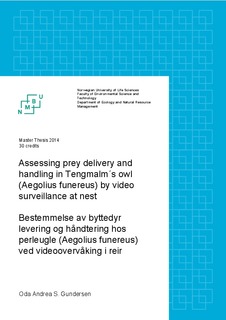Assessing prey delivery and handling in Tengmalm's owl (Aegolius funereus) by video surveillance at nest
Master thesis
Permanent lenke
http://hdl.handle.net/11250/221402Utgivelsesdato
2014-09-24Metadata
Vis full innførselSamlinger
- Master's theses (INA) [593]
Sammendrag
Prey delivery and handling at four Tengmalm's owl (Aegolius funereus) nests was assessed by video monitoring in an increase year for the vole population. A total of 179 prey items was recorded delivered at the nest, and 121 of those where identified as voles. Microtus voles (Field vole (Microtus agrestis) and Root vole (Microtus oeconomus)pooled) made up 39% of the prey items and 51% of the prey mass, suggesting that these were the most important prey. Bank vole (Myodes glareolus) was delivered relatively more often early in the season, and in the morning hours, whereas Microtus voles were a more frequent prey among the delivered prey items late in the season. The Tengmalm's owl tended to deliver prey items in runs, as prominent in a win-stay strategy, and shrews (Sorex sp.) were the most likely prey hunted by use of this strategy. Whether a prey was decapitated prior to delivery at the nest was affected by prey body mass and time since solar midnight (SM), where the probability of decapitation increased with prey body mass and time since SM. Prey handling at the nest was conducted by the female until the nestlings were 18 days old. They were then able to handle the prey items independently.
